I’ve talked a lot in class about why we start each day with silent reading time, but I haven’t shared the philosophy behind this ritual with many of our parents. Since it’s an important part of our ELA program, and I’m incredibly passionate about literacy, I want to explain it further in this blog post. (As you read through this post, please remember that data to support my thoughts can be found in the sources listed at the end.)
Studies consistently show that teenagers are reading less and less each year, and overall rates of reading comprehension are declining because of it. With so many competing interests- social media, video games, Youtube, afterschool activities, etc.- this isn’t a surprise, but it is a big problem. Reading correlates with countless positive life outcomes, including the ability to be a better speaker, writer, employee and global citizen.
Here are some specific details to further explain these claims, taken from the sobering report found below:
- Reading scores and reading proficiency rates for students of all genders and ages have declined nationwide. This decline in reading proficiency correlates with weakened writing skills.
- Struggling readers are far more likely than skilled readers to drop out of high school.
- Employers now rank reading and writing as top deficiencies in new hires.
- Less advanced readers report fewer opportunities for career growth and lower paying job opportunities.
I can personally attest to the correlation between literacy and employability. Before becoming a teacher, I worked in Human Resources as a hiring manager and recruiter. Many of the open jobs I worked to fill brought in a hundred or more applicants and resumes. The first and fastest way to sort through the countless applicants for each job was to notice grammar, spelling and punctuation errors as I read the resumes. If a job applicant couldn’t use correct grammar and spelling, what assumptions could I make of them as a potential employee?
But the good news is that reading more frequently (and for pleasure) correlates with academic and career achievement.
Specifically:
- Voluntary readers are better readers and writers than non-readers. (They score better on reading and writing tests than non-readers or infrequent readers).
- Good readers generally have greater post-secondary academic success and higher paying jobs once entering the workforce.
- Good readers are better-informed citizens and tend to be more involved in their community in terms of volunteerism and cultural engagement.
The “for pleasure” qualifier above is an important distinction. If students are forced to read only academic texts throughout their schooling or must always take a quiz or write a report when they read a novel, they’ll graduate without experiencing the pleasure and enjoyment that can be found in reading. Afterall, as an adult reader, I know I’d lose my love of reading pretty quickly if I had to do a report or write a paper after every novel or book I read. What fun is that?
Looking at these facts, it’s easy to see that our students need to be reading enjoyable books and articles far more often than they do in a traditional one-book-for-the-whole-class literacy program.
But even if teachers let students select their own reading materials, there’s usually little to no quiet reading time outside of school. This isn’t a criticism of parenting, but rather an acknowledgment that we are all so busy. With after-school activities, sports, family and church events, and homework, there is very little free, quiet time for our adolescents to read for fun.
Therefore, we made the decision to give up some direct instructional class time in sake of quiet reading time each class (silent reading is usually 15 minutes a day). This silent reading time comes with the ability for students to select their own reading material. To support this, we’ve also worked hard to build a Junior High specific library with interesting and current books and magazines (thank you for all your book donations).

Our library and some of our librarians
So far, the results of our silent reading time and free choice reading have been positive. Most students report reading three to four times the number of books this school year compared to previous years, and there are countless students who never loved reading before but are now hooked. In other words, we’ve introduced some students to the love of reading, and we couldn’t be happier. And remember, this does NOT come at the expense of weakened writing skills. Good readers ARE good writers, thinkers, and speakers.
Is this program perfect? The answer is no. We need to continue building the Junior High library so we can find and offer the perfect book to excite those students who still don’t love reading. (I get it! I used to cry out of frustration when doing math homework. We can’t all love the same things.) I also have goals for my summer professional development so I can be an even teacher better for our students next year. But our goal is to help our students be successful in life, and this correlates directly with reading ability, so I’ll keep working to share books with our students.
Some ways in which we get students excited about reading, besides giving them the time to read and a JrH specific library is by doing book talks, hosting two different book clubs, and sharing student written book reviews on this blog. In addition, we always have lots of great books on display in our classroom, and each day countless students grab new books or pass books they’re excited about over to their friends. We even have a waiting list for some of our most popular new release books.


Our “book talk” display- it changes daily because we keep finding open spots where books have been checked out.
If you’re a parent reading this, you might wonder what you can do to support your student’s literacy success and our overall ELA program. If that’s the case, I have three suggestions:
- If you see your student reading just for fun, please remember it’s a good thing. I know it’s easy to think if they’re not reading a textbook they’re not benefiting, but that’s not the case.
- If you have books at home that your family won’t read again, please consider donating them to our class library.
- And please help us get all of our library books back to the classroom at the end of the year. It’s easy for your student to set one of the books aside and forget it’s there. So when you see one of our books in your teenager’s super clean bedroom (I joke), please remind them to bring it back when they’re finished with it.
If you would like to read more about the points presented in this blog post, check out the resource list below. If you have questions or want to talk about our literacy program, please don’t hesitate to contact me by email (SLucyk@mariamontessoriacademy.org) or drop by to visit after school. I’m always happy to discuss our literacy program and additional resources and scholarly articles not included at the end of this post.
Ms. Shilo
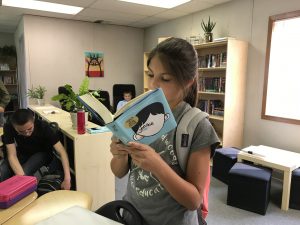
Some of our students read as class ends (standing up with their backpack on!).
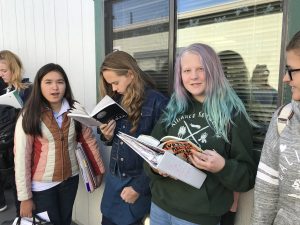
Some of them read outside on the boardwalk between classes.
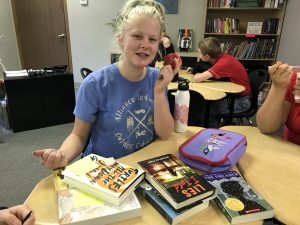
Some of our students even read (6 books) during lunch.
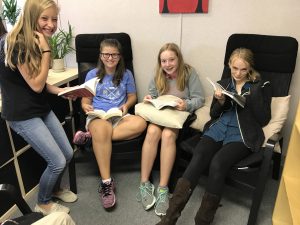
Or they read with a smile.
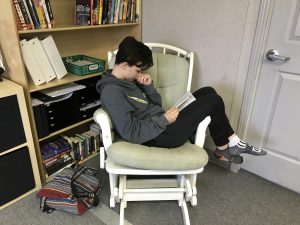
Or they read in deep concentration.
But no matter how they do it, all of our students read!
Sources:
“To Read or Not To Read. A Question of National Consequence.”
Gallahger, Kelly. Readicide. How Schools Are Killing the Love of Reading and What You Can Do About it.
Kittle, Penny. Book Love. Developing Depth, Stamina, and Passion in Adolescent Readers.
Miller, Donnalyn. The Book Whisperer: Awakening the Inner Reader in Every Child.
